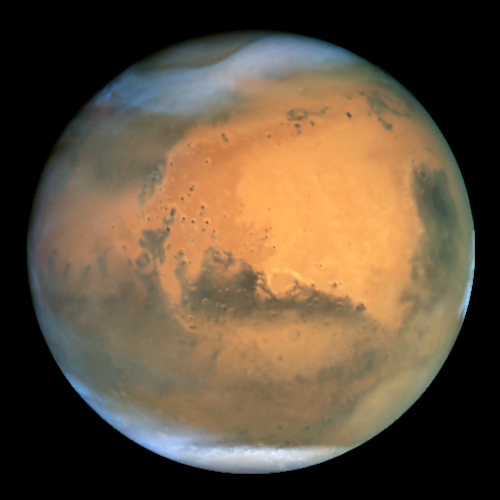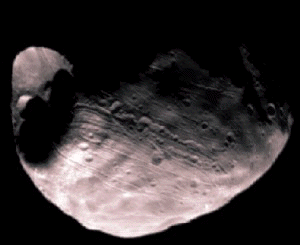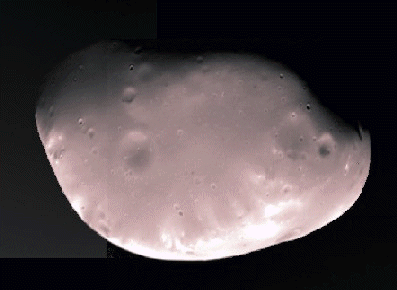
Mars From the Hubble Space Telescope
The photo of Mars, (Above), was taken by the Hubble Space Telescope in March of 1997 and is one of the more striking photographs taken of Mars. The bluish haze around Mars is the very thin atmosphere, primarily composed of Ice Clouds. Clearly visible is the ice cap at the north pole.
Mars is the fourth planet from the Sun, positioned between Earth and Jupiter. Its orbit around the Sun takes a wide elliptical pattern, with Mars being about 128 million miles from the Sun at its closest point to 154 millions away at its furthest point. The Martian year is equal to 687 Earth days with the Martian day being equal to 24 hours and 37 minutes here on Earth. Mars' diameter is about 4070 miles or is just a little more than half the size of Earth. Mars has an iron core center. Surrounding the iron core is a layer of rock, but it is much thicker than that of Earth's crust. Mars' close approaches to Earth range from 35 million to 63 million miles due to its elliptical orbit around the Sun. In Roman mythology, Mars was named after the god of war, (Greek name, Ares).

The best time to observe Mars, with or without a telescope, is in the night sky from spring through early summer. In late summer to late fall, Mars normally undergoes a massive annual dust storm which will obscure most all its pronounced features on the surface.
Moon's of Mars
The two moons of Mars, Phobos and Deimos, are very small and are among the smallest moons in our entire solar system. Phobos is about 18 miles in diameter with Deimos being much smaller at about 9 miles in diameter. The two Martian moons are actually considered to be asteroids that were caught by Mars gravity and fell into an orbit around the red planet. Impact craters can be seen of the moon's surface and were caused by much smaller astroids colliding with them. The largest impact crater can be seen on the left side of Phobos.

Mars' Moon Phobos

Mars' Moon Deimos
The Smallest Moon in the Solar System
Mars' Grand Canal
Valles Marineris canyon system is over 2486 miles long and up to 5 miles deep. It extends from the Noctis Labyrinthus to the chaotic terrain on the east side. As a mental visual aid, this canal is so large, it would streach from Boston, MA to almost Flagstaf, AZ. Three Tharsis volcanoes are visible to the left (dark red spots) on Mars. They rise 6 to 11 miles above the Tharsis Plateau, attaining elevations of 11 to 16 miles.
Mars has a rocky, dusty surface, complete with clouds and dust storms that can cover the whole planet at once. The weather on Mars is very cold, with an average temperature of around ten below zero. During the Martian winter, the temperature can drop to 160 degrees below zero! During the Martian winter, the planet has ice caps at the north and south poles like Earth. The difference is that these caps are made of frozen carbon dioxide, or "dry ice". Mars also has mountains, sandy deserts and many, many inactive volcanoes. Mars has the largest volcano in the solar system, Olympus Mons, which is over 45,000 feet tall, much higher than Mount Everest, and is over 600 miles wide at its base. There are also many canyons on Mars, including the one in the picture above, Valles Marineris, which is over two thousand miles long and deep enough to hold a mountain range.

Back To Main Menu
Use the "BACK" button on your Browser to return to the previous page.